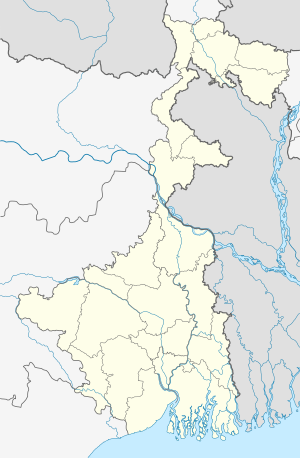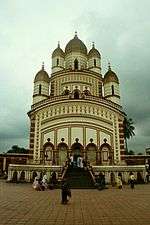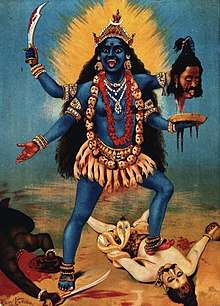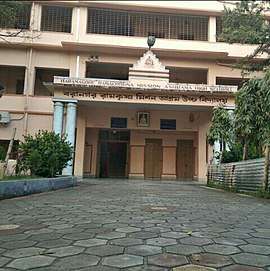Kalighat Kali Temple
Kalighat Kali Temple is a Hindu temple in Kalighat, Kolkata, West Bengal, India dedicated to the Hindu goddess Kali.[1] It is one of the 51 Shakti Peethas.
| Kalighat Kali Temple | |
|---|---|
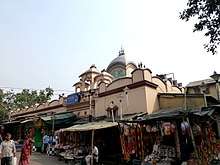 View of the Kalighat Temple | |
| Religion | |
| Affiliation | Hinduism |
| Deity | Kali |
| Festivals | Kali Puja |
| Location | |
| Location | Kolkata |
| State | West Bengal |
| Country | India |
| Geographic coordinates | 22°31′12″N 88°20′31″E |
| Architecture | |
| Type | Bengal |
| Completed | 1809 |
| Website | |
| kalighattemple | |
Kalighat was a Ghat (landing stage) sacred to Kali on the old course (Adi Ganga) of the Hooghly river (Bhāgirathi) in the city of Kolkata. The name Calcutta is said to have been derived from the word Kalighat. The river over a period of time has moved away from the temple. The temple is now on the banks of a small canal called Adi Ganga which connects to the Hooghly. The Adi Ganga was the original course of the river Hooghly. Hence the name Adi (original) Ganga.
Legend
Kalighat is regarded as one of the 51 Shakti Peethas of India, where the various parts of Sati's body are said to have fallen, in the course of Shiva's Rudra Tandava. Kalighat represents the site where the toes of the right foot of Dakshayani or Sati fell.
Kalighat is also associated with the worship offered to Kali by a Dasanami Monk by name Chowranga Giri, and the Chowringee area of Calcutta is said to have been named after him.
History
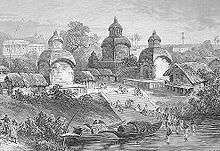
The Kalighat temple in its present form is only about 200 years old, although it has been referred to in Mansar Bhasan composed in the 15th century, and in Kavi Kankan Chandi of the 17th century. The present structure of the temple was completed under the Sabarna Roy Chowdhury family's patronage in 1809. Mention of the Kali temple is also found in Lalmohon Bidyanidhis's 'Sambanda Nirnoy".[2] Only two types of coins of Chandragupta II, who incorporated Vanga in the Gupta Empire, are known from Bengal. His Archer type coins, which became the most popular type of coinage with the Gupta rulers after Kumaragupta I, have been found in Kalighat. This is evidence of the antiquity of the place.

The image of Kali in this temple is unique. It does not follow the pattern of other Kali images in Bengal. The present idol of touchstone was created by two saints - Atmaram Brahmachari and Brahmananda Giri. Presently, the three huge eyes, long protruding tongue made of gold and four hands, which all are made of gold too. Two of these hands holding a scimitar and a severed head of the asura king 'Shumbha'. The scimitar signifies Divine Knowledge and the asura (or, human) head signifies human Ego which must be slain by Divine Knowledge in order to attain Moksha. The other two hands are in the abhaya and varada mudras or blessings, which means her initiated devotees (or anyone worshiping her with a true heart) will be saved as she will guide them here and hereafter.
Temple details
Shoshti Tala

This is a rectangular altar about three feet high bearing a small cactus plant. Beneath the tree, on an altar three stones are placed side by side - left to right representing the goddesses Shashthi (Shoshti), Shitala and Mangal Chandi. This sacred spot is known as Shoshti Tala or Monosha Tala. This altar was constructed by Gobinda Das Mondal in 1880. The place of the altar is the Samadhi of Brahmananda Giri. Here all the priests are female. No daily worship or offering of Bhog (food offering) is done here. The goddesses here are considered as part of Kali.
Natmandir
A large rectangular covered platform called Natmandir has been erected adjacent to the main temple, from where the face of the image can be seen. This was originally built by Zamindar Kasinath Roy in 1835. It has been subsequently renovated often.
Jor Bangla
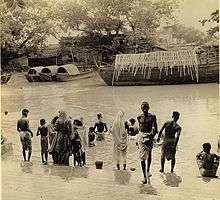
The spacious verandah of the main temple facing the image is known as Jor Bangla. Rituals occurring inside the sanctum sanctorum are visible from the Natmandir through the Jor Bangla.
Harkath Tala
This is the spot adjacent to the Natmandir, southwards meant for Bali (sacrifice). There are two Sacrificial altars for animal sacrifices side by side. These are known as Hari- Kath.
Radha-Krishna Temple
This temple is known as Shyama-raya temple and is situated inside the temple at the west side of the main temple. In 1723, a settlement officer of Murshidabad district first erected a separate temple for Radha-Krishna. In 1843 a Zamindar called Udoy Narayan Mondal erected the present temple in the same spot. The Dolmancha was founded in 1858 by Madan Koley of Saha Nagar. There is a separate kitchen for preparation of vegetarian Bhog (food offering) for Radha-Krishna.
Kundupukur

This is the sacred tank situated in the south-east of the temple outside the boundary walls. Present area of the tank is approximately 10 cottahs. In the past it was bigger and called 'Kaku-Kunda'. The 'Sati-Anga' (the right toe of Sati) was discovered from this tank. It is believed that taking a dip in this small pond/ tank can bestow one with the boon of a child. The water from this tank is regarded as sacred as that of the Ganges.
There had been futile efforts in the past of draining the water from the tank for cleaning, which creates a strong possibility of a subterranean link with the Adi Ganga.
The Kalighat Temple as a Shakti Peeth
The Temple at Kalighat is revered as an important Shakti Peetha, by the Shaktism sect of Hinduism. The mythology of Daksha yajna and Sati's self immolation is the story behind the origin of Shakti Peethas.
Daksha, the son of Brahma was an ancient entity called Prajapati or the keeper of the beings in Hinduism. He had a lot of daughters, one of whom was Sati, an incarnation of the Primordial Mother Goddess or Shakti. She was married to Shiva, the ascetic, whose abode was in the cold and snowy recesses of the Kailasa Parvat. Daksha had frowned upon the marriage, as Shiva was a penniless man, quite unlike the King that Daksha was. In time, Daksha decided that he would arrange a yajna or a ritual where he would invite all the gods, except for Shiva. Sati, his daughter came to her father's place, uninvited and faced a flurry of insults from her father about her husband. Unable to bear the insults, she immolated herself. The news of the death of his beloved wife set Shiva on a delirious rage, as he started the Tandav or the Dance of Destruction with the body of Sati, calming down, only when Vishnu managed to chop her body down into fifty one pieces, which would fall all over the length and breadth of India. (A lot of these places are in modern day Pakistan and Bangladesh as well.)
Shakti Peethas or divine seats of Shakti or the Primordial Mother Goddess, thus came into being wherever these severed parts of Sati's body had fallen.
Each of the 51 Peethas have a temple dedicated to the Shakti or the Primordial Mother, and a temple dedicated to the Bhairava or Shiva, the All-Father, essentially forming important historical centres to mark the marriage of Shaivism and Shaktism, and also the philosophical fact that a man is nothing without his Shakti or Woman and vice versa.
The Shakti here is thus Dakshina Kali (the benevolent Mother of the World) while the Bhairav being Nakulish or Nakuleshwar.
It is believed that the right big toe of Sati fell here at Kalighat. However, some Puranas also mention that the Mukha Khanda (face) of the Goddess fell here, got fossilized, and is stored and worshipped here.
The 51 Shakti Peethas are linked to the 51 alphabets in Sanskrit, each carrying the power to invoke one of the goddesses associated with them. These Alphabets are called Beeja Mantras or the seeds of the primordial sounds of creation. The Beeja Mantra for Dakshina Kali is Krīm.
The mythological texts which include the Kalika Purana (Ashtashakti,) recognize the four major Shakti Peethas—Bimala where resides the Pada Khanda (feet) (the temple is inside the Jagannath Temple, Puri, Odisha), Tara Tarini housing the Stana Khanda (Breasts), (near Brahmapur, Odisha), Kamakshya, Yoni khanda (vagina) (near Guwahati, Assam) and Dakshina Kalika, Mukha khanda (in Kolkata, West Bengal) originated from the lifeless body of the goddess Sati.
This is illustrated in a hymn from the Kalika Purana (Ashtashakti):
“Vimala Pada khandancha,
Stana khandancha Tarini (Tara Tarini),
Kamakhya Yoni khandancha,
Mukha khandancha Kalika (Kali)
Anga pratyanga sangena
Vishnu Chakra Kshate nacha……”
Further explaining the importance of these four Peethas the Brihat Samhita gives the geographical location of these Peethas. For example:
“Rushikulya Tate Devi,
Tarakashya Mahagiri,
Tashya Srunge Stitha Tara,
Vasishta Rajitapara"
Thus, there is no dispute regarding these four Adi Shakti Peethas and their locations. These four Peethas are also believed as the most powerful Shakti Peethas in Bharata Varsha. However, all these Four Adi Shakti Peethas are also part of 51 Shakti Peethas but there are four major parts of Devi Sati's body So, they are important, powerful and believed as Adi Shakti Peethas.
Associated Temples
Nakuleshwar Bhairav Temple

This Bhairav temple is dedicated to the consort of Dakshina Kali. It is situated in Haldar Para Lane on the opposite side of the temple behind the Kalighat Police Station. This temple too is an ancient one.
The four Shiva temples inside the Kalighat temple compound were constructed by the different sevayet families who have retained control over them.
See also
Notes
- Balakrishnan, S (9 May 2003). "Kali Mandir of Kolkata". The Hindu. Retrieved 10 November 2009.
- Bangiya Sabarna Katha Kalishetra Kalikatah by Bhabani Roy Choudhury, Manna Publication. ISBN 81-87648-36-8
References
- Rachel Fell McDermott; Jeffrey John Kripal (2005). Encountering Kali: In the Margins, at the Center, in the West. Motilal Banarsidass. ISBN 978-81-208-2041-8.
